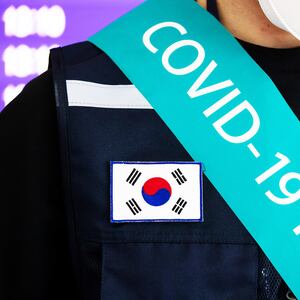U.S. President Donald Trump wants South Korea’s help fighting the COVID-19 pandemic. Good idea. No country has a better record containing the disease while allowing the uninfected to go about their lives. But Trump’s desire to squeeze and humiliate one of America’s closest allies seems to have gotten the better of him.
For reasons never clearly elucidated, last year Trump decided to demand Seoul pay $5 billion for the Americans based on Korean territory—which is more than five times the current contribution. And his negotiators are not backing down on demands the U.S. military be dealt with essentially as a mercenary force that will pack up and go if its price is not met.
Victor Cha at the Center for Strategic and International Studies in Washington sees U.S. policy on South Korea, including negotiations on the bases, as part and parcel of Trump’s overall outlook on foreign policy. “After three years of transactional diplomacy,” he says, “the hegemon no longer values alliances” and “you can see why each country is only thinking about itself.”
ADVERTISEMENT
“If the two allies are starting to cooperate on COVID, I would say that is long overdue,” Cha told The Daily Beast. And South Korean companies are eager to begin shipping test kits and ventilators. But Cha added darkly, “What is striking about the pandemic response is that the allies are not working together, not coordinating responses, not sharing needs.”
The excruciating spectacle of Trump diplomacy was on full display this week when the commander of the 28,500 U.S. troops in Korea struck a note of retreat if not surrender. Gen. Robert Abrams had the unpleasant duty of laying off more than half the 8,600 Korean nationals (KN, as they’re called) working on U.S. bases. “This is an unfortunate day for us,” he proclaimed. “It’s unthinkable,” he added, piling on the verbiage. “It’s heartbreaking.” This “is not what we envisioned or hoped would happen,” he said.
Although few expect South Korea to pay anything close to the $5 billion demanded, the impasse is symptomatic of Trump’s disdain for carefully wrought deals in which the U.S. has built vital relationships around the world.
So, incredibly, one set of Trump negotiators have continued to bargain hard about the U.S. bases in Korea while the White House is pleading with South Korea’s President Moon Jae-in for “equipment,” i.e., test kits and ventilators, produced quickly and in volume by Korean manufacturers.
“The first case of COVID was identified on the same day [Jan. 20] in both South Korea and the U.S.,” says Bruce Klingner, who analyzes Korean issues at the Heritage Foundation in Washington, “but Seoul quickly took action to develop test kits while President Trump downplayed the seriousness of COVID.”
South Korea has since registered almost 9,976 infections and 169 deaths, according to the Johns Hopkins Coronavirus Research Center count as of 4:00 a.m. Thursday in Washington D.C. That's three deaths per million people, as calculated by Worldometers. The United States has registered 216,722 infections, 5,137 deaths, or 15 per million. South Korea's infection curve is almost flat. The American curve continues to take off like a ballistic missile. COVID-19 has killed eight times more people in New York City alone than in all of South Korea.
So, not to put too fine a point on it, Trump screwed up. And now he wants help from the people he’s trying to screw.
Klingner says the final deal on the bases “will have to come from one or both of the presidents since there is such a large gap between the positions.” But, he fears, “the issue is not on the American public's radar right now and Trump will feel little pressure to change in the near term.”
The absence of urgency in the Trump White House no doubt helps account for the inability of negotiators to come to terms by Wednesday, April 1, triggering the furlough notices threatened by the U.S. weeks ago. The rough details look something like this: Trump is determined to force the South Koreans to pay substantially more for their ally’s bases than the $927 million they paid last year, which already was 8 percent more than the year before. South Koreans reportedly are offering a 10 percent increase this year—a figure the Americans have been rejecting while spurning a piecemeal South Korean offer for the South to go on paying just the salaries of the South Korean workers.
This is the first time the U.S. has laid off Korean workers since the U.S. Forces Korea command was established in 1957, and the impasse horrifies Americans with long records of military service in the country.
“What we are doing is a self-inflicted wound on the alliance,” said David Maxwell, a retired army colonel who served in the U.S. special forces in Korea.
Maxwell suggests suspending negotiations for two years while extending funding at the current level. “Then when we get through the coronavirus crisis we can resume negotiations,” he said. U.S. refusal of the South Korean offer to fund South Korean workers, he believes, “makes it seem like we are conducting brinkmanship and willing to use the Korean workers as pawns.”
Compounding the problem is the whole question of what’s going on in North Korea, and the way Trump has chosen to deal with it, or not. Kim Jong Un has ordered a series of tests of short-range ballistic missiles while battling the disease that’s assumed to have cost lives and weakened his grip over his own people even though not a single case on the official record.
Trump has gone far out of his way to try to build on the great relationship that he claims to have forged with Kim at their summit in Singapore nearly two years ago.
The North’s Korean Central News Agency last month quoted Kim’s younger sister, Kim Yo Jong, saying that Trump “expressed his intent to render cooperation in the anti-epidemic work” and “that he was impressed by the efforts made by the Chairman [Kim Jong Un] to defend his people from the serious threat of the epidemic.” Strangely, North Korea reported the letter, leaving the White House in a position where it had to confirm, yes indeed, Trump had sent such a missive!
As for whatever the U.S. might be willing to provide North Korea, says Klingner, “it was likely just a generic offer of assistance” and “a moot point because Pyongyang did not reply except indirectly with more missile launches.”
While North Korea refuses to reveal how many have been infected and died from COVID-19 and its complications, increasingly tight restraints on movement of people and illicit cross-border dealings with China—officially banned when the illness first showed up in the North—suggest significant suffering.
Maxwell worries that “a widespread outbreak” in North Korea “could lead to destabilization of the regime”—an eventuality that could persuade Kim to divert attention with more missile tests and make him even more reluctant to give up the nukes he surely never intended to part with in the first place.
The threats posed by North Korea were a problem “solved,” Trump declared in the summer of 2018, but in the coronavirus era it appears his problems on the peninsula have only just begun.






